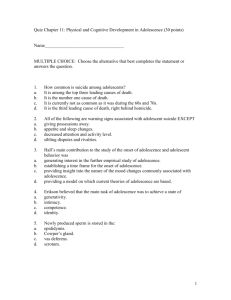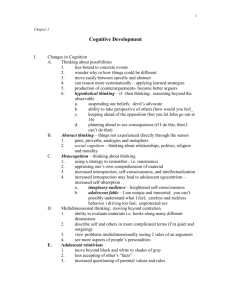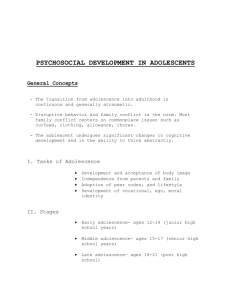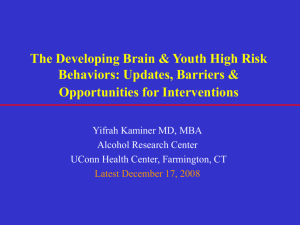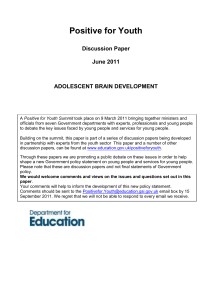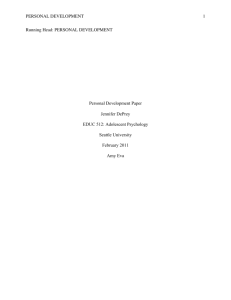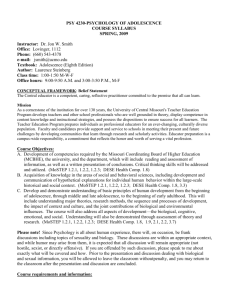Module A1: Definitions of Adolescence and Overview of bio
advertisement
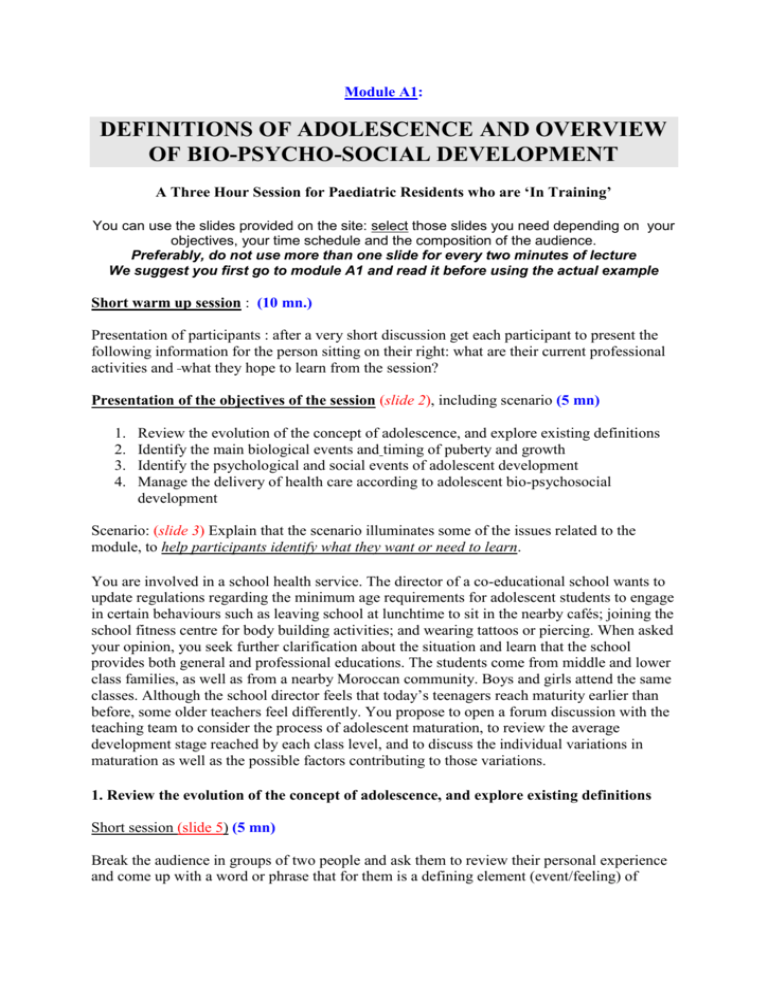
Module A1: DEFINITIONS OF ADOLESCENCE AND OVERVIEW OF BIO-PSYCHO-SOCIAL DEVELOPMENT A Three Hour Session for Paediatric Residents who are ‘In Training’ You can use the slides provided on the site: select those slides you need depending on your objectives, your time schedule and the composition of the audience. Preferably, do not use more than one slide for every two minutes of lecture We suggest you first go to module A1 and read it before using the actual example Short warm up session : (10 mn.) Presentation of participants : after a very short discussion get each participant to present the following information for the person sitting on their right: what are their current professional activities and what they hope to learn from the session? Presentation of the objectives of the session (slide 2), including scenario (5 mn) 1. 2. 3. 4. Review the evolution of the concept of adolescence, and explore existing definitions Identify the main biological events and timing of puberty and growth Identify the psychological and social events of adolescent development Manage the delivery of health care according to adolescent bio-psychosocial development Scenario: (slide 3) Explain that the scenario illuminates some of the issues related to the module, to help participants identify what they want or need to learn. You are involved in a school health service. The director of a co-educational school wants to update regulations regarding the minimum age requirements for adolescent students to engage in certain behaviours such as leaving school at lunchtime to sit in the nearby cafés; joining the school fitness centre for body building activities; and wearing tattoos or piercing. When asked your opinion, you seek further clarification about the situation and learn that the school provides both general and professional educations. The students come from middle and lower class families, as well as from a nearby Moroccan community. Boys and girls attend the same classes. Although the school director feels that today’s teenagers reach maturity earlier than before, some older teachers feel differently. You propose to open a forum discussion with the teaching team to consider the process of adolescent maturation, to review the average development stage reached by each class level, and to discuss the individual variations in maturation as well as the possible factors contributing to those variations. 1. Review the evolution of the concept of adolescence, and explore existing definitions Short session (slide 5) (5 mn) Break the audience in groups of two people and ask them to review their personal experience and come up with a word or phrase that for them is a defining element (event/feeling) of ‘adolescence.’ These are written on slips of paper which are then posted, and can be referred to during the lecture on definitions, as well as in other parts of the session. Or, use the developmental grid provided on slide 66 to put some of the experience/events that participants recall, cording to whether they are biological, psychological, and social. Interactive lecture (slides 6-15) (20mn.) Using the comments from the audience as a background, provide traditional concepts of adolescence (Erikson, Piaget, etc.), compare with WHO and national definitions of adolescence. Emphasize that adolescence should be seen as a process. You can of course use your own slides and other references ! 2. Identify the main biological events and timings of puberty and growth Short session : (5 mn.) List and rank by order of frequency the questions or problems brought up by female and male adolescents (and their parents) about growth and puberty. Compare the two sexes/genders, Interactive lecture (select from slides 17-45) (~45 mn) The growth spurt / growth velocity during adolescence Definition of BMI, overweight and obesity Tanner stages and their impact on development BREAK 3. Identify the psychological and social events of adolescent development You can use the result of short session 1 as a background for the discussion here Short interactive lecture (slides 47-53): (10 mn.) Developmental tasks of adolescence The three phases of adolescence: early, middle and late Discussion: (15-20 mn) : what is a normal adolescent ? (slides 54-58) 4. Managing the delivery of health care according to adolescent bio-psychosocial development Group exercice (20 mn) (slide 60-63) Using the developmental grid (appendix 1 of module A1/slide 63), each group should consider the stage of development of the adolescents in the above examples, both from the biological and psychosocial point of view, and provide messages / answers which are appropriate for their this stage of development Each group is offered a specific situations such as : 1. A 14 year-old boy binge drinks every weekend with his friends. 2. A 16 year-old girl is having unprotected sex; she is sure she cannot become pregnant because her menses are irregular. 3. A 12 year-old boy rides a cycle without a protective helmet 4. A 19 year old girl asks for a 100% safe contraception because she previously experienced an abortion 5. A 16 year-old boy who takes dubious body building substances (or he has access to steroids!) because his ice hockey coach told him to “get bigger and stronger fast”. 6. A 14 year-old who wants a physician’s certificate that she/he can work after school for a local store loading and unloading (heavy) merchandise. . Plenary discussion with ideas from each group (15 mn) Wrap-up, evaluation of the session (10 mn.) (slide 64)

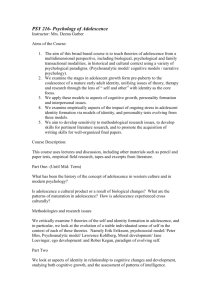

![Adolescence in 20th Century Literature and Culture [DOCX 16.08KB]](http://s3.studylib.net/store/data/006806148_1-4fb552dd69cbfa44b08b2f880802b1fe-300x300.png)
